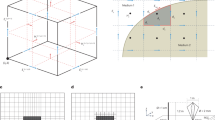Abstract
The dipole approximation is employed to describe interactions between atoms and radiation. It essentially consists of neglecting the spatial variation of the external field over the atom. Heuristically, this is justified by arguing that the wavelength is considerably larger than the atomic length scale, which holds under usual experimental conditions. We prove the dipole approximation in the limit of infinite wavelengths compared to the atomic length scale and estimate the rate of convergence. Our results include N-body Coulomb potentials and experimentally relevant electromagnetic fields such as plane waves and laser pulses.
Similar content being viewed by others
References
Bach, V., Fröhlich, J., Sigal, I.M.: Quantum electrodynamics of confined nonrelativistic particles. Adv. Math. 137, 2 (1998)
Costin, O., Lebowitz, J.L., Stucchio, C.: Ionization in a 1-dimensional dipole model. Rev. Math. Phys. 20, 7 (2008)
Fröhlich, J., Pizzo, A., Schlein, B.: Ionization of atoms by intense laser pulses. Ann. Henri Poincaré 11, 7 (2010)
Glimm, J., Jaffe, A.: Singular perturbations of selfadjoint operators. Commun. Pure Appl. Math. 22, 3 (1969)
Graffi, S., Yajima, K.: Exterior complex scaling and the AC-Stark effect in a Coulomb field. Commun. Math. Phys. 89, 2 (1983)
Griesemer, M., Schmid, J.: Well-posedness of non-autonomous linear evolution equations in uniformly convex spaces. Math. Nachr. 290, 2–3 (2017)
Griesemer, M., Zenk, H.: On the atomic photoeffect in non-relativistic QED. Commun. Math. Phys. 300, 3 (2010)
Huang, M.-J.: Commutators and invariant domains for Schrödinger propagators. Pac. J. Math. 175, 1 (1996)
Kato, T.: Linear evolution equations of “hyperbolic” type. J. Fac. Sci. Univ. Tokyo Sect. I, 17 (1970)
Møller, J.S.: Two-body short-range systems in a time-periodic electric field. Duke Math. J. 105, 1 (2000)
Pauli, W., Fierz, M.: Zur theorie der emission langwelliger lichtquanten. Il Nuovo Cimento 15, 3 (1938)
Radin, C., Simon, B.: Invariant domains for the time-dependent Schrödinger equation. J. Differ. Equ. 29, 2 (1978)
Reed, M., Simon, B.: Methods of Modern Mathematical Physics, Vol. II: Fourier Analysis, Self-Adjointness. Academic Press, Cambridge (1975)
Yajima, K.: Resonance for the AC-Stark effect. Commun. Math. Phys. 87, 3 (1982)
Yosida, K.: Functional Analysis. Springer, Berlin (1980)
Acknowledgements
We thank Detlef Dürr and Peter Pickl for many helpful discussions and the referees for their advice.
Author information
Authors and Affiliations
Corresponding author
Rights and permissions
About this article
Cite this article
Boßmann, L., Grummt, R. & Kolb, M. On the dipole approximation with error estimates. Lett Math Phys 108, 185–193 (2018). https://doi.org/10.1007/s11005-017-0999-y
Received:
Revised:
Accepted:
Published:
Issue Date:
DOI: https://doi.org/10.1007/s11005-017-0999-y




